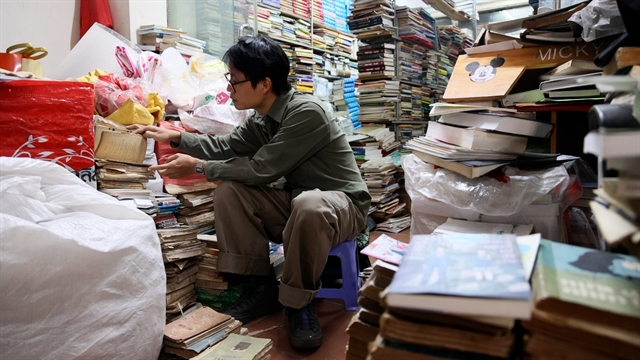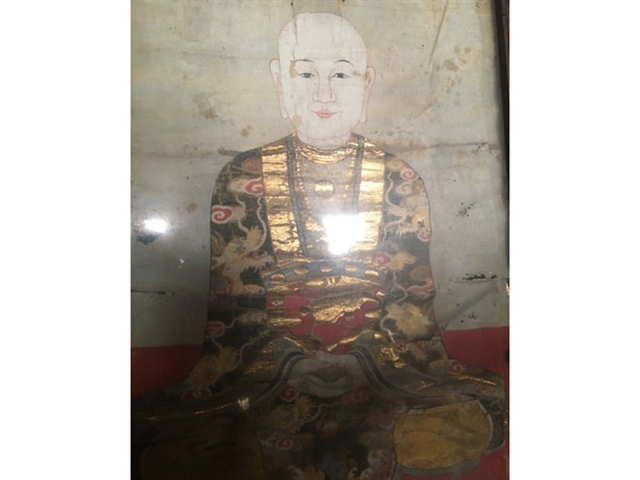 Life & Style
Life & Style

The painting is believed to feature a portrait of monk Nguyễn Minh Không (Lý Quốc Sư) (1065-1141) and has been kept in Thánh Nguyễn Temple in Ninh Bình Province.

|
| Ancient painting believed to feature monk Nguyễn Minh Không. Photos thanhnien.vn |
NINH BÌNH Cultural experts have sounded the alarm over the deterioration of a rare and ancient painting.
The painting is believed to feature a portrait of monk Nguyễn Minh Không (Lý Quốc Sư) (1065-1141) and has been kept in Thánh Nguyễn Temple in Ninh Bình Province.
According to painter Phạm Bá Ngọc, the painting has been folded too small to fit into a storage box.
"The box and the painting surely don't fit one another" he said. "Folding too small has resulted in many cracks on the painting due to pleats over a long time."
Lý Quốc Sư (National Monk of the Lý dynasty) was the title the Lý kings gave to Monk Nguyễn Minh Không, who led Buddhism under the Lý reign. He was considered the initiator of many pagodas in Việt Nam and the ancestor of bronze casting handicraft.
Having made great contributions to curing illnesses for royal families and people, the monk and General Trần Hưng Đạo (1228-1300) have been praised as Saint Nguyễn and Saint Trần and are worshipped at many temples and pagodas throughout the country.
The painting, which is guessed to date back 400-500 years, is only exhibited at the temple for important events, while the rest of the time it is been kept in the box.
Researcher Trần Hậu Yên Thế expressed his admiration for the techniques used in the painting.
“It was made with a very difficult technique of gilding gold on a silk background while all drawing lines were painted with gold,” he told Việt Nam News.
He revealed he had seen some similar paintings outside Việt Nam.
“They ground gold, then make the drawing lines,” he guessed. “They may have made the background with paint, then put gold powder on the surface and drew the lines.”
“That’s why the costume of the monk in the picture looks very special,” Thế said. “The inner sweater the monk wears looks beautiful. It is as smooth as if it were covered with gold powder.”
Thế said he found the painting similar to worship paintings of Vajrayana Buddhism, called thangka paintings.
He said a typical technique thangka paintings apply is using many thin pieces of gold on the painting to depict glamourous costumes.
“Using thin gold pieces on a silk painting is unique,” he said. “The gold was gilded on the costume in a complex way. Gold may be gilded in the position of the coat’s edge, on rosary beads, on the head of dragon pattern on the monk’s coat.”
Thế said he had seen the same way of gilding gold in Tibet, where after gilding gold, decorative patterns are drawn on the same place in a painting.
“The drawing capability of the monk painting’s drawer must be of master level,” Thế said. “As I know in order to draw on the surface of gold, the colours should be special. It might have been paint or some kind of glue made from plants, with which drawing thin lines is not simple at all.”
Thế also said the use of Vajrayana Buddhism features in the painting is consistent with Buddhism during the Lý reign.
In the monk’s coat, there are images of dragons with five claws, which concerned the king, royal family and mandarins. Normal people would not have this kind of pattern on their clothes.
“The way that the painter featured the monk in such a royal coat implied the monk was a national leading monk of the Lý dynaty, who has once rescued King Lý Thần Tông (1116-1138),” Thế guessed.
Journalist Nguyễn Quốc Phong, who helped examine the painting recently, could not hide his concern over the present situation of the painting.

|
| The painting is folded small to fit the small box that contains it. |
“I hope Ninh Bình Culture, Sports and Tourism Department will soon have a plan to preserve the painting to avoid it becoming more worn out,” Phong told Thanh Niên News.
He suggested the National Fine Arts Museum buy the painting to restore it properly.
Thế has asked artisan Nguyễn Đăng Giáp, who has restored many ancient paintings, to get involved, but Giáp said he has not ever restored such a painting.
“The gold gilded area is very bright, so I think the gold might have been imported from Tibet,” Thế said. “We may transfer the painting to other countries to better restore it like to South Korea or Japan, where there are many more experienced experts in the field.”
Nguyễn Thu Hòa, director of Ceramic Museum, also a collector of ancient paintings, said the painting should be restored and then given back to the temple.
“If the painting is so special, there are only two experts that can restore it in Hà Nội,” she said.
Hòa was referring to Nguyễn Văn Đức, who specialises in silk, gold and silver techniques in Bát Tràng Village, and Lê Quốc Việt, a painter who researches royal promotion decrees and calligraphy.
Đặng Văn Bài, deputy chairman of the Việt Nam Heritage Association, said the locality should restore the painting soon.
“It’s most important to figure to a careful, thorough and scientific method of restoration,” he said.
He warned failure to do so could lead to an incident similar to what happened to the national treasure lacquer painting Vườn Xuân Trung Nam Bắc (Spring Garden of North, Central and South) by painter Nguyễn Gia Trí (1908-1993) at HCM City Fine Arts Museum last year.
After 30 years being kept at the museum, the lacquer painting had some damage on the surface, so museum cleaners used kitchen soap, sandpaper and powdered cinnabarite to clean it.
The improper cleaning scraping some of the outer paint off and removed the intricacies in Trí's work.
The painting is the largest lacquer work in the country, which took Trí 20 years to finish and is considered one of his greatest works.
The masterpiece depicts a spring festival with revelers wearing different traditional costumes from localities across Việt Nam. VNS